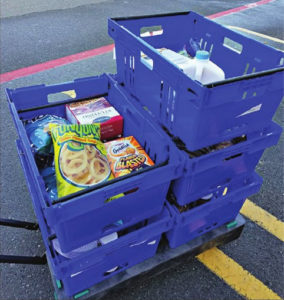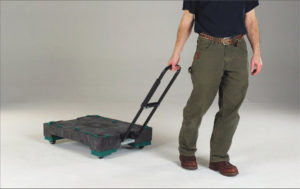The New Normal: eCommerce Boom Drives Changes in Supply Chain Packaging
By Andrea Nottestad, Senior Product Manager at Orbis
 March marks one year since the material handling industry as we knew it changed forever and the supply chain became front and center to today’s consumers. Over this past year, we’ve seen explosive growth in the world of eCommerce. While the COVID-19 pandemic illuminated the global nature of our supply chain and accelerated the adoption of eCommerce, increased consumer expectations are also driving this new normal.
March marks one year since the material handling industry as we knew it changed forever and the supply chain became front and center to today’s consumers. Over this past year, we’ve seen explosive growth in the world of eCommerce. While the COVID-19 pandemic illuminated the global nature of our supply chain and accelerated the adoption of eCommerce, increased consumer expectations are also driving this new normal.
As a result of this eCommerce boom, packaging is becoming a more integral (but often underappreciated) consideration within fulfillment. To accommodate our current reality and meet consumer demand for online orders, retailers are reevaluating their packaging solutions.
Micro-fulfillment and BOPIS expansion
eCommerce is no longer just in distribution centers; it’s in the stores themselves. As a result of the pandemic, many retailers shifted their models to implement the buy online, pick up in store (BOPIS) practice, while simultaneously growing their curbside capabilities. Models for BOPIS are now occurring more regionally, using hub stores, dark stores and micro-fulfillment centers. While these centers allow retailers to consolidate their eCommerce activity and provide greater picking efficiencies, this model requires different packaging to accommodate the smaller space and consumer-centric environment.
Picking containers are nestable for space savings and stackable to easily assemble orders. Mobile pallets support picking, delivery, staging and curbside fulfillment in one single base platform. These solutions can work from micro-fulfillment centers to the store floor. With curbside pickup continuing to rise, integrated tote and cart systems provide store associates with a space-friendly mobile system to pick and fulfill orders. Ergonomic and portable, reusable packaging simplifies eCommerce operations and reduces order pick times to meet demand.
Rise in in-store fulfillment
To accommodate a surging demand for grocery delivery and pickup, many retailers are now using their stores for fulfillment. Back rooms are small, and the resulting space constraints are huge. Retailers are looking for ways to optimize their backroom and maximize space for store operations, while still providing ease of use for associates. What’s more, associates are also picking online orders at the same time alongside their customers, making it important for retailers to consider how their packaging might interface with a customer versus at an off-site distribution center.
Packaging used for picking must be nondisruptive to in-store customers. Retailers must now ask themselves whether their packaging will fit down narrow aisles, and lock in place to prevent rolling and injury should a customer brush past while an associate is picking. By incorporating reusable packaging solutions, retailers can optimize in-store processes for efficient online order fulfillment, while seamlessly interfacing with customers.
For example, reusable plastic mobile dollies with sturdy handles and wheel brakes support associates as they conduct picking and deliver product car-side. These solutions are smooth to the touch, meaning they can be safely used alongside customers. Knowing that BOPIS activity is cyclical, the ability to stack, nest or collapse packaging when not in use allows retailers to limit the space needed for assets.
 The need for automation grows
The need for automation grows
To address the costs for increasing speed to the consumer, companies are looking toward automation in their DCs and fulfillment centers. But to adopt more automated practices, companies must also reevaluate the packaging used throughout the supply chain. Automated environments require standardized, dimensionally consistent containers and pallets, a need that can be met with reusable plastic packaging.
The standardized nature of reusable packaging allows it to better interface with automated systems, reducing jams and improving the flow of product along the supply chain with little to no system downtime. Downtime is not only inefficient, but also leads to costly delays in picking and delivery. To keep up with consumer demand, companies must ensure that the packaging used within their automated practices won’t cause stops within high-speed systems.
Intersection with sustainability
Today’s savvy consumers now demand a focus on waste reduction and recyclability – at every point in the supply chain. They want to buy from brands that have sustainable operations and supply chains. When many consumers think of eCommerce, they often think of its arrival at their doorstep; but there’s a whole other side to eCommerce before it reaches the end user. With companies getting closer to the consumer to accommodate eCommerce sales, they’re becoming more conscious of the packaging used not only for the final mile of delivery, but also back in the supply chain. Reusable packaging helps satisfy consumers craving sustainability.
Reusable packaging supports the three R’s in the environmental hierarchy by designing out waste (reduce), keeping products in use longer (reuse), and repurposing packaging at end of life (recycle). Not only will companies reduce shipping and waste disposal costs with reusable packaging, they’ll also make a positive impact on the environment.
The future of packaging for eCommerce operations
The future of retail will play a leading role in the type, size and material of packaging used for eCommerce. But there’s one thing that is certain: eCommerce is here to stay, and companies must adapt in order to compete. eCommerce touches many points in the supply chain and companies are finding there is significant opportunity in having an effective eCommerce strategy. The key? Start now by evaluating your packaging solutions to find the most efficient and effective ways to support eCommerce fulfillment.







